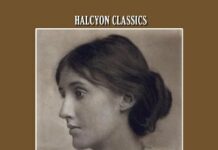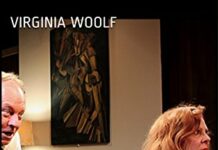
Ebook Info
- Published: 2005
- Number of pages: 102 pages
- Format: EPUB
- File Size: 0.29 MB
- Authors: Virginia Woolf
Description
Heralded as Virginia Woolf’s greatest novel, this is a vivid portrait of a single day in a woman’s life. When we meet her, Mrs. Clarissa Dalloway is preoccupied with the last-minute details of party preparation while in her mind she is something much more than a perfect society hostess. As she readies her house, she is flooded with remembrances of faraway times. And, met with the realities of the present, Clarissa reexamines the choices that brought her there, hesitantly looking ahead to the unfamiliar work of growing old.”Mrs. Dalloway was the first novel to split the atom. If the novel before Mrs. Dalloway aspired to immensities of scope and scale, to heroic journeys across vast landscapes, with Mrs. Dalloway Virginia Woolf insisted that it could also locate the enormous within the everyday; that a life of errands and party-giving was every bit as viable a subject as any life lived anywhere; and that should any human act in any novel seem unimportant, it has merely been inadequately observed. The novel as an art form has not been the same since. “Mrs. Dalloway also contains some of the most beautiful, complex, incisive and idiosyncratic sentences ever written in English, and that alone would be reason enough to read it. It is one of the most moving, revolutionary artworks of the twentieth century.” –Michael Cunningham, author of The Hours
User’s Reviews
Reviews from Amazon users which were colected at the time this book was published on the website:
⭐Sydney M. WilliamsMrs. Dalloway, Virginia WoolfFebruary 12, 2022“She felt very young; at the same time unspeakably aged. She sliced like a knife through everything; at the same time was outside, looking on.” Mrs. Dalloway, 1925 Virginia Woolf (1882-1941)In this short novel – 166 pages in my edition – Virginia Woolf provided vignettes and flashbacks, in kaleidoscopic fashion, to tell the story of one day in the life of Clarissa Dalloway: “She was not old yet. She had just broken into her fifty-second year.” We learn that she is preparing for a party that evening. The novel’s opening sentence – “Mrs. Dalloway said she would buy the flowers herself” – is almost as well-known as that of Jane Austen’s Pride and Prejudice – “It is a truth universally acknowledged…”The story takes place on a June day in London, in 1923. The Great War has been over for five years, except for those who suffered. A reminder of its devastation is Septimus Warren Smith and his Italian wife Rezia: “he had gone to France to save England.” Now home, his mood – a consequence of “shell shock” – swings from mourning his friend Evans, who was killed in Italy a few days before the Armistice, to febrile joy. His suicide serves as contrast to the gala of Mrs. Dalloway’s party.Mrs. Dalloway’s home was near Westminster Bridge where she lived with her MP husband Richard and seventeen-year-old daughter. Richard: “…he liked continuity, and the sense of handing on the traditions of the past.” Elizabeth: “…charming to look at,” but “she never seemed excited.” We hear Clarissa reminisce, as she crosses Green Park to Piccadilly, walks past Hatchards to Mulberry’s florist on Bond Street. It is the passage of time – punctuated by Big Ben’s chimes – that dominate the story. Earlier, Clarissa received Peter Walsh, a beau from her youth who had spent the intervening years in India. She invites him to her party. Separately, an old friend Sally Seaton, now Lady Rosseter comes by and is also invited to the party. These visits and the memories they evoke provide flashbacks to the turn of the Century when as young people they gathered at Clarissa’s family’s country home, Bourton, for parties and games.The party includes old friends and Parliamentary acquaintances of Richard, including the Prime Minister: “He looked so ordinary. You might have stood behind him and bought biscuits…” Peter Walsh observes that no one looked at him, yet they “felt to the marrow…this symbol of what they all stood for, English society.” Others at the party are described, in Virginia Woolf’s inimical voice: Sir Harry, “…who had produced more bad pictures than any other two Academicians in the whole of St. John’s Wood.” Professor Brierly, “…his innocence blent with snobbery.” Lord Gayton, “Ponies mouths quivered at the end of his reins.” Clarissa, according to Richard, was criticized unfairly for her parties, though he thought they were foolish, as excitement was bad for her heart. Her childhood friends thought she enjoyed having famous people about. But they were wrong; her parties were celebrations of life: “What she liked was simply life. ‘That’s what I do it for,’ she said, speaking aloud, to life.”This is a short novel, providing the reader vivid images and witty commentary on an age and time gone by.
⭐Though there are some passing resemblances to Jane Austen, the comedy of manners, and Victorian narrative satire, this is a modernist novel and a fairly accessible introduction to Woolf, unless the reader is overly impatient or tone-deaf. Woolf creates a character’s interior life through a virtuosic, highly mobile third-person narrator, who might be thought of as the character’s “persona,” not merely “expressing” the character’s thoughts but “mirroring” how the character perceives him or herself as seen by others. Moreover, the indefinite pronouns can shift unexpectedly or occur in too close proximity to make identification easy or even definite. As a result, the reader has to work overtime to achieve entrance into the mind of the “right” character while simultaneously sensing the liquid, interpenetrating and shared qualities of human identity itself. And finally there’s that tone, now soft, now loud, and rarely without irony.Woolf makes it fairly easy on the reader with the broad, sardonic strokes she uses to paint the practically villainous Sir William Bradshaw, the eminent psychiatrist viewed by many (especially himself) as the scientific high priest of this cross-section of deluded London luminaries; and she’s equally nasty to her other “villain,” Miss Kilman, a repressed and embittered born-again Christian who, like Sir William, lives by the code of “conversion,” Woolf’s euphemism for those powerful personalities who are bent upon breaking, controlling and dominating the will of anyone not strong enough to resist them. The other portraits are more subtle, requiring the reader either to hear the soft, nuanced ironical tones or risk missing both the social satire and the character. Woolf’s targets range, perhaps not surprisingly, from the pretense, pride, and hypocrisy of an out-of-touch social stratum that clings to the “orderly” past; to the arrogance of modern medical “science”; to, more surprisingly, the suffocating alternatives offered by both religion and love. She uses the term “Human Nature” ironically, making it refer to those individuals who cannot see with understanding, empathy or vision, substituting for “life” the ego’s own conventional, reductive and limited sense of a world that’s all surface and order.Readers lured to this novel because of Cunningham’s “The Hours” (novel or film) may be disappointed or quickly frustrated. Moving from Cunningham to Woolf is a bit like going from Fitzgerald to Faulkner, or from Austen to Shakespeare. What you immediately notice is the far greater range and more inclusive thematic focus and, most importantly, the sheer power and vitality of the prose (from fluid motion to dynamic rush). Woolf–like Joyce, Faulkner, and Shakespeare–employs a syntax that can cause the head to spin and the earth: she’s a writer who represents not merely individual characters but captures a microcosm of life not to mention the life of language itself.The greatest challenge “Mrs. Dalloway” presents to a first-time reader is never to let up. It’s essential to stay with Clarissa throughout her entire day, finally becoming a fully engaged participant in the party itself–the final thirty pages of the novel, which contain some of Woolf’s best writing. Especially critical is the extended moment, almost 20 pages into the party scene, when Clarissa, like Septimus, walks to the window and has her epiphany. It’s a moment highly reminiscent of Gabriel Conroy’s singular internal struggle and ultimate attainment of vision in the closing paragraphs of “The Dead” (Woolf was not especially fond of Joyce, but it’s hard to believe she was not influenced by him). At that moment, Clarissa sees her affinity and even oneness with Septimus, a character who suffers internally but is capable of resisting the worse alternative of the “cures” offered by Dr. Bradshaw, one of the guests at Clarissa’s own party. The insight produces action: one character chooses death; the other, life. But Woolf enables us to see these apparently opposite choices as existential cognates: both characters make choices that enable them to save their souls. (The “Death of the Soul” is a theme introduced early in the novel by the insightful Peter, a “failure” by society’s standards and his own admission and someone who cannot get the better of his fixations–on the irretrievable past and his own youth. By the story’s end, it is not Peter but Clarissa who presents a whole and integrated self, capable of separating the illusory from the real, of the once dependent “Mrs. Dalloway” from the newly enlightened “Clarissa.”Cunningham is a first-rate stylist and craftsman who can tell a story that’s moving and evocative, a narrative, moreover, that connects with today’s readers by affirming the choices available to the self. But it feels like a mechanical assembly next to the vibrant novel that is its source and inspiration. Ms. Woolf, like her character Clarissa, knows how to throw a party.
⭐I have read this book many times and noticed that the text is not the original but can find nothing to say that is the case. The first line immediately alerted me ‘Mrs Dalloway said she might buy the plants herself’ should read ‘Mrs Dalloway said she would buy the flowers herself.’ Plants/flowers, might/would – why you may say make a fuss? Because the book was written by Virginia Woolf who wrote in a very particular, precise and poetic way. She should not be re-written. Certainly not without indication that modifications have been made.I have been unable to post my comment without giving the book a rating so I have given it a nominal 1 star which is an over-rating in my opinion.
⭐Very disappointing. Found this version almost impossible to read, it just didn’t make sense, seemed like random words had just been flung on the page. I eventually realised that this must be something to do with the digitisation (?). Had it been automised , or done by a computer or non- English speaker from a verbal recording instead of a written text?I have since bought the Penguin classic version from Kindle and this is fine. I am enjoying the read.Doesn’t warrant a star rating but had to give a minimum of 0ne to submiy this review.Do not buy this version.
⭐I didn’t finish this read. I have little to say about it. I found it fairly one dimensional, which is ironic, considering this is a novel studied by millions across the globe. The characters are suitably postmodern, giving little to know and less to like. The style of writing is wonderfully advanced given its time, however, Mrs. Dalloway herself is so unbelievably dull that I just can’t bring myself to care about anything that she has to say. As I understand, the story improves in the latter half. Unfortunately, I have a short attention span for prose of this kind and if it doesn’t grab my attention in the initial chapters it swiftly ends up on the ‘half read’ pile.
⭐All the text in this book is garbled. Luckily I knew the book already so could see that it has been transcribed so poorly that it makes no sense. It should be removed from sale.
⭐A re-read for me of this 1920s srream of consciousness classic novel.The book concerns the eponymous Mrs Dalloway, who as the wife of an inter war years member of Parliament living in Westminster Llondon, is preparing to host a dinner party, and the action takes place within a 24 hour period.The novel is written in a stream of consciousness style. And it looks at many different and variouus topins including politics, celebrity, fa.mily, live, suicide and much more.I enjoyed Mrs Dalloway although i dont think i enjoyed it as much as ” To The Lighthouse, which i both rated as four star reads.
Keywords
Free Download Mrs. Dalloway in EPUB format
Mrs. Dalloway EPUB Free Download
Download Mrs. Dalloway 2005 EPUB Free
Mrs. Dalloway 2005 EPUB Free Download
Download Mrs. Dalloway EPUB
Free Download Ebook Mrs. Dalloway





